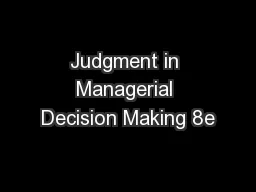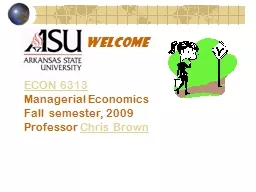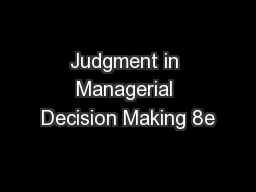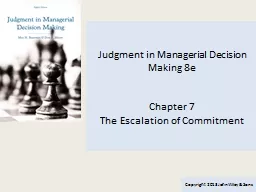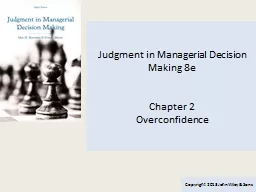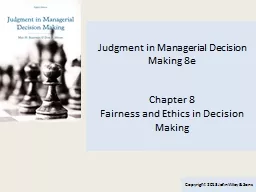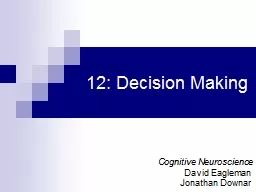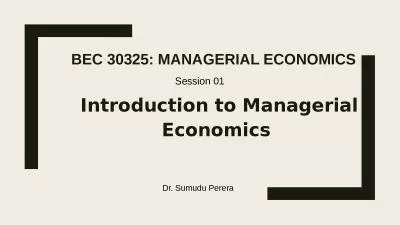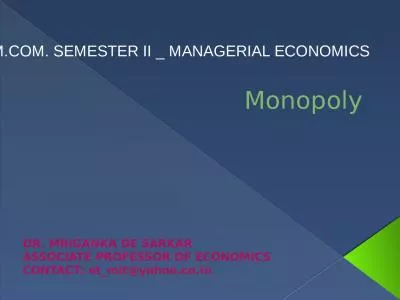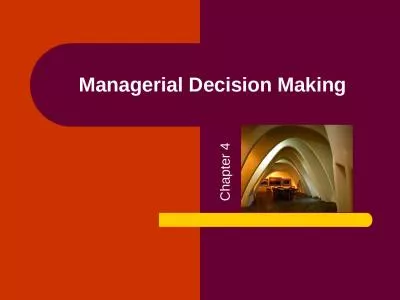PPT-Judgment in Managerial Decision Making 8e
Author : tawny-fly | Published Date : 2015-10-16
Chapter 4 Bounded Awareness Copyright 2013 John Wiley amp Sons Problem 1 RolePlaying Exercise S ix people are randomly assigned to the roles A B C D E and F A
Presentation Embed Code
Download Presentation
Download Presentation The PPT/PDF document "Judgment in Managerial Decision Making 8..." is the property of its rightful owner. Permission is granted to download and print the materials on this website for personal, non-commercial use only, and to display it on your personal computer provided you do not modify the materials and that you retain all copyright notices contained in the materials. By downloading content from our website, you accept the terms of this agreement.
Judgment in Managerial Decision Making 8e: Transcript
Chapter 4 Bounded Awareness Copyright 2013 John Wiley amp Sons Problem 1 RolePlaying Exercise S ix people are randomly assigned to the roles A B C D E and F A is randomly selected and given 60 to allot among A B C D E and F The amounts given to B C D E and F must be equal but this amount may be different from the amount that A allocates to A herselfhimself B C D E and F will be asked to specify the minimum amount that they would accept If the amount offered by A to each of B C D E and F is equal to or greater than the largest amount specified by B C D E or F the 60 will be divided as specified by A If however any of the amounts specified by B C D E and F are larger than the amount offered by A all six parties will receive 0 . Sarah Lennon. Inclusion Ireland. Overview. The current situation in Ireland. Context for Change. Typical Case Studies. The Future. Currently in Ireland. Status Approach to Capacity. Decision that someone ‘lacks capacity’. ECON 6313. Managerial Economics. Fall semester, . 2009. Professor . Chris Brown. Outline. What is managerial economics and why should you study it?. Examples of managerial decisions. Six steps to decision making. Chapter . 10. Making Rational Decisions in Negotiations. Copyright 2013 John Wiley & Sons. Game Theoretic Approaches. Provides precise prescriptive advice. Relies on describing all outcomes. Assumes all parties are rational. Chapter . 7. The Escalation of Commitment. Copyright 2013 John Wiley & Sons. The Escalation of Commitment. Committing to an initial decision. Competition and escalation. Explanations for escalation. Chapter 2. Overconfidence. Copyright 2013 John Wiley & Sons. Write Your 98% Confidence Intervals. Point Estimate. Lower Estimate. Upper Estimate. Wal-Mart’s 2010 revenue. Google’s 2010 revenue. . decisions. in . conditions. . of. . information. . uncertainty. Tomas . Macak. MANAGEMENT THEORY. Faculty of Economics and Management. Department of Management. Organization of teaching. Consultation time: Monday from 10.00 to 11.30 in the morning. Office No. E 468 (4th floor of the building of the Faculty of Business and Economics). Phone: 224 382 029, email: macak@pef.czu.cz. Chapter . 8. Fairness and Ethics in Decision Making. Copyright 2013 John Wiley & Sons. Accepting a Job Offer. You are graduating from a good MBA program. Subsequent to your discussions with a number of firms, one of your preferred companies makes you an offer of $110,000 a year, stressing that the amount is not negotiable. You like the people. You like the job. You like the location. However, you find out that the same company is offering $120,000 to some graduating MBAs from similar-quality schools. . Introduction. Information, Decisions, and Management. Decision Support Technologies. OLAP and DSS. DSS Applications in Corporate Functional Management. Practitioners of Management Science. Achieving Success with Analytics. Cognitive Neuroscience. David Eagleman. Jonathan . Downar. Chapter Outline. How Do We Decide What to Do?. The Predictably Irrational . Homo sapiens. Where Do Our Irrational Decisions Come From?. How the Brain Decides. Have you ever been so involved in watching a movie that you react emotionally or feel a part of the action?. If so, then you have been deeply involved with a work of art.. After you see a new movie or TV program you might recommend it to a friend or tell them not to waste their time. You are judging the show and making decisions about why it was a failure or success. . Disclosures:. Narayanaswami . P. (PI) . AHRQ . Grant Number: 1R18HS022004-01. AAN: . Guidelines Development, Dissemination and Implementation subcommittee and Practice Committee. Allergan: . Speakers bureau, advisory board, and injector training. Introduction to Managerial Economics . Session . 01. Dr. . Sumudu. . Perera. Nature . and scope of Managerial Economics. Goals . and Constraints of business organizations. The . Theory of the firm. The . DR. MRIGANKA DE SARKAR. ASSOCIATE PROFESSOR OF ECONOMICS. CONTACT: et_mit@yahoo.co.in. Monopoly: Why?. Natural monopoly (increasing returns to scale), e.g. (parts of) utility companies?. Artificial monopoly. Chapter 4. 2. Managerial Decision Making. Decision making is not easy. It must be done amid . ever-changing factors . unclear information . conflicting points of view. 3. Definition : Decision . Making.
Download Document
Here is the link to download the presentation.
"Judgment in Managerial Decision Making 8e"The content belongs to its owner. You may download and print it for personal use, without modification, and keep all copyright notices. By downloading, you agree to these terms.
Related Documents

